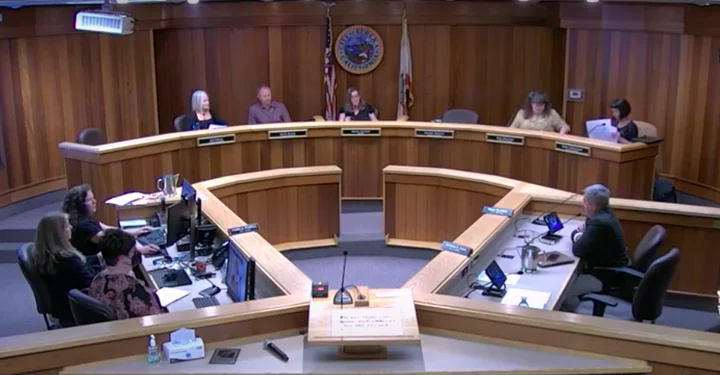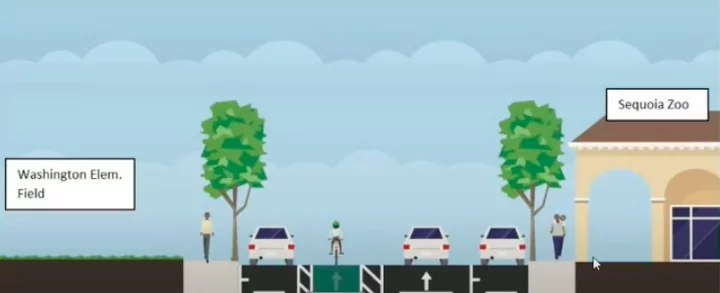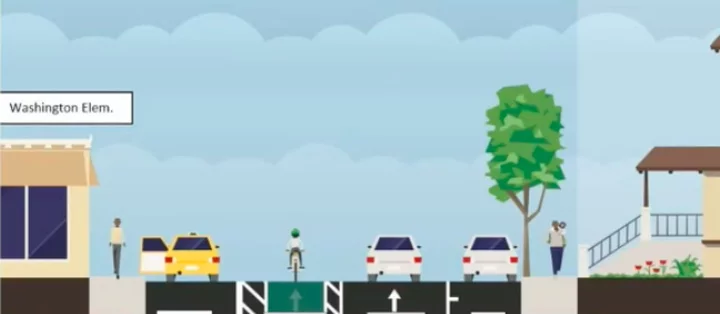Screenshot of Tuesday’s Eureka City Council meeting.
Impassioned residents of Cutten, Eureka and Myrtletown packed into Eureka City Hall on Tuesday evening to weigh in on one question: Should Dolbeer and W streets transition to one-way traffic?
Eureka city staff conducted a one-way traffic experiment, or “couplet demonstration,” on Dolbeer and W streets between Chester and Hemlock streets back in August. The two-lane roads currently run parallel to each other, one block apart, with traffic rolling past the Sequoia Park Zoo and Washington Elementary School. During the couplet demo, staff reduced W Street to one lane heading southbound and Dolbeer to one lane heading northbound. Hemlock Street, which forms a sort of horseshoe connecting the two, was also restricted to one lane with vehicles going west-to-east.
Why do this, you ask? The city is trying to enhance connectivity between Cutten and Eureka and make the whole area more bike-friendly. City staff believe the couplet project would also alleviate pedestrian safety concerns in the area as “one-way streets tend to have lower collision rates,” according to the staff report.
The experiment was criticized by commuters and folks living in the surrounding neighborhoods who complained that the one-way alignment led to traffic jams and increased travel time. And, because the demo took place during summer break, parents and representatives of the Eureka City Schools District argued that the city did not have an accurate picture of how the couplet project would impact traffic during the school year.
W Street | Screenshot
Dolbeer Street | Screenshot
The two dozen members of the public who offered their two cents were divided on the matter. Half of the speakers were in favor of the project, with several suggesting modifications, while the other half were opposed.
Rick Knapp, founder and president of Humboldt Bay Bicycle Commuters Association, expressed support for the project but asked staff to reconsider having the bike lane on the left side of the roadway.
“If we build a bike lane on the left side, it will be the only one in the city,” he said. “There’s a certain advantage to having consistency. I’m thinking about me riding on Hodgson [Street] eastbound and now I’ve got to get across the lane of traffic and get over into this other lane to the left. When I get to Hemlock [Street], I have to cross the lane of traffic again because I’m on the left side of the vehicles. I’m not convinced that this is a good way to go with a bike lane. I like being on the right side.”
Victoria Bryant also expressed support for the project but suggested a second traffic study take place during the school year to accurately observe traffic impacts.
“I thought the one-way change helped reduce a lot of conflicts at the intersections involved – which can be pretty high conflict intersections – not only between two lanes of two-way traffic but with pedestrians and cyclists as well. …Overall, I thought that it caused some disruption, which is to be expected, but I think that a lot of people would just end up rerouting themselves. …We’re talking about a couple of seconds or minutes.”
Susan Johnson, a member of the Eureka City Schools Board of Trustees, raised concern for student safety.
“I just wanted to speak to concerns for child safety and kids getting in and out of the car with the passenger side being on the street side instead of on the curb,” she said. “[The kids would] have to walk between cars that are on and could move forward while they’re walking between. I think that’s the main concern that I have is the safety of the children coming in and out of the school.”
First District Humboldt County Supervisor Rex Bohn criticized the city for failing to include the county in initial conversations surrounding the project proposal.
“Our Public Works Department was kind of left out of this. Our director didn’t know anything – I didn’t know anything – about [the demonstration] ‘til the day it was happening and my phone started ringing. …I just think a little more collaboration because you’re going to need to feed into [the county’s] intersection to make this happen.”
Eureka City Schools District Superintendent Fred Van Vleck and Washington Elementary School Principal Teri Silvers echoed Bohn’s concerns over the city’s lack of communication and argued against increased traffic around the school’s campus. “I am not a traffic expert, I can guarantee Teri is not a traffic expert but we are school experts,” Van Vleck said. “Why do we want to put more traffic around students? It just doesn’t make sense.”
After about two hours of discussion – half of which was public comment – the weary council decided to continue the discussion at a future meeting.
“There’s a lot to digest here,” Councilmember Natalie Arroyo said. “I think it might be helpful to provide a little bit of input to staff about what we’d like to hear a little more information about. … There are engineering solutions to almost all of the problems that were identified tonight.”
Councilmember Leslie Castellano suggested the council take part in a study session with the city’s Transportation Safety Commission. The council considered holding a study session on Thursday but ultimately agreed that the short timeframe wouldn’t provide staff with enough notice to answer their questions.
The council will schedule a study session in the coming weeks. A recording of the meeting can be found here.



CLICK TO MANAGE